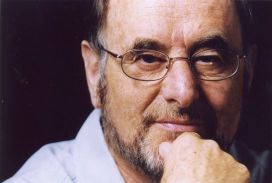
Sir Roger Norrington
|
At 76,
Britain’s Sir Roger Norrington can hold both an audience and an orchestra in
the palm of his hand, as he did with the Cincinnati Symphony Orchestra Friday
morning at Music Hall. It was his third visit to the orchestra, having made his CSO debut in 2006.
Prime mover of the early music movement -- now morphed into “authentic performance practice” and spanning Bach to Berlioz (and beyond) –Norrington opened the CSO’s 2010-2011 Mozart Festival with works by Mozart and Haydn. Whether high schoolers or retirees, he kept the audience engaged with his trademark blend of warmth, wit and expertise, prompting calls to make his guest conducting visits an annual event.
The program, which he led completely from memory, comprised Mozart’s Divertimento for Strings in D Major, K.136; Haydn’s Sinfonia Concertante in B-flat Major, Op. 84; and Mozart’s Symphony No. 36 in C Major, K.425 (“Linz”). Stepping out of the CSO ranks to solo in the Haydn were concertmaster Timothy Lees, principal cellist Ilya Finkelshtyn, principal oboist Dwight Parry and principal bassoonist William Winstead.
The concert also gave the audience a taste of what the huge hall may be like when the Music Hall Revitalization Project, now in the crucial pricing estimate phase, is completed. The current plan is to move the orchestra downstage, i.e. further into the hall, to optimize acoustics and foster greater intimacy with the audience (Music Hall currently seats 3,516). For this weekend’s concerts (repeat is 8 p.m. Saturday in Music Hall), the acoustical towers, usually aligned upstage behind both proscenium arches, were positioned flush with the inner arch in a horizontal line behind the players. The stage was extended outward, as for opera productions, but with the orchestra onstage instead of in the pit. Norrington conducted without a podium or a baton in a semi-circular space carved out in front of the musicians.
It made for a compelling experience, especially if you sat in the sections closest to, or overlooking the stage.
Norrington opened with an ensemble of 21 strings in Mozart’s delightful Divertimento in D Major, K.136. He may have looked reserved when he walked onstage, but not a moment later he was transformed, carving out the music with his hands, face and body. Not that anything was done to excess. Sir Roger became the music, and his presence was enough to enthrall the musicians. A slowly raised right hand elicited a crescendo from the violins. He conducted in phrases to indicate the character of the music, attending to the beat as necessary, and bringing out sometimes piquant details.
There was an
orchestra of 40 in the Haydn Sinfonia Concertante, plus the four soloists. As in the Divertimento, the strings played without
vibrato except for soloists Lees and Finkelshtyn. The performance was exquisite – period. There was a touching sweetness to Lees’ solos,
warmth and agility from Finkelshtyn, both players venturing into their highest
registers. Parry and Winstead are superb
soloists whenever they perform, and Haydn's Sinfonia Concertante was no exception.
Norrington kept close watch on the soloists to keep ensemble precise, and communication was extraordinary. There wasn’t a nano-second’s delay between the end of Lees’ ritardando (slowing of the tempo) and the entrance of the orchestra in the last bars of the finale.
Mozart’s “Linz” Symphony was a repeat from Norrington’s last visit in 2009. Named for a charming town on the Danube near Salzburg, Austria, it is a charmer by more than just association, delightfully tuneful and filled with Mozartean grace. Norrington spiced up his gestures with a kick or a little “run up” to the players now and then, as if he were about to attack them. It was all for emphasis, however, as he complimented the CSO between movements with silent claps of his hands.
Tempos were lively, and the music was finely nuanced. The Trio of the Menuetto, for oboe, two violins, viola and double bass, was particularly winsome, as were Norrington’s occasional sideways glances at the audience. Near the end of the final movement (Presto), he raised his hands high into the air as if to signal the peak of the Symphony. He turned to the audience with a flourish at the end, to the delight of everyone in the hall.
Encore, Sir Roger.